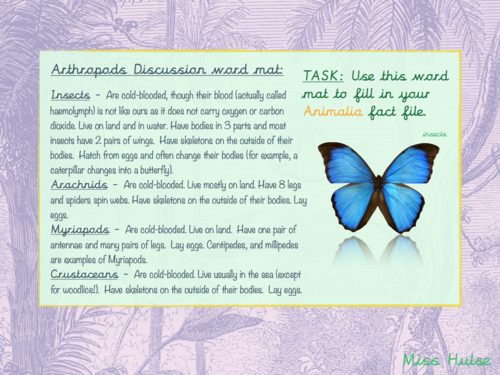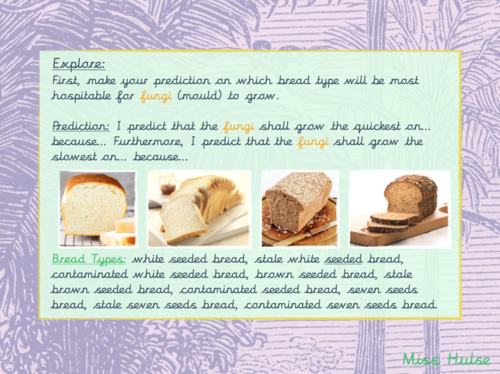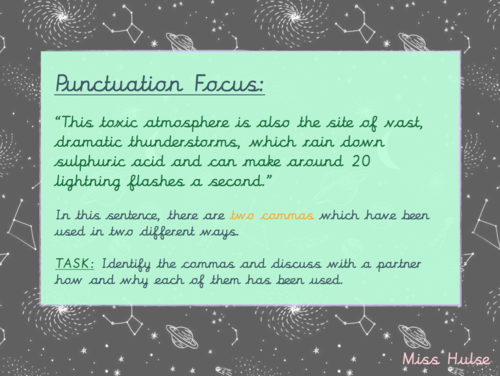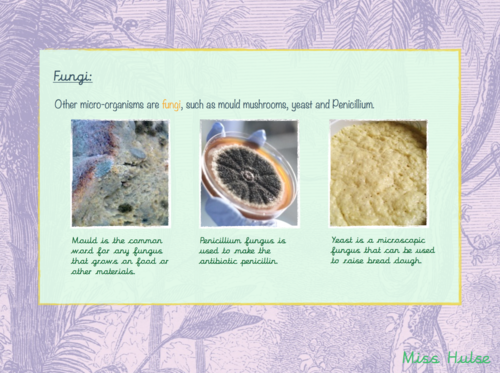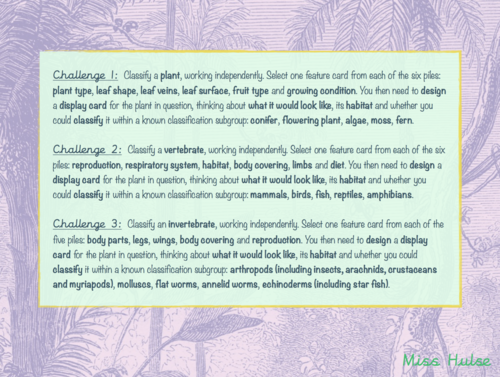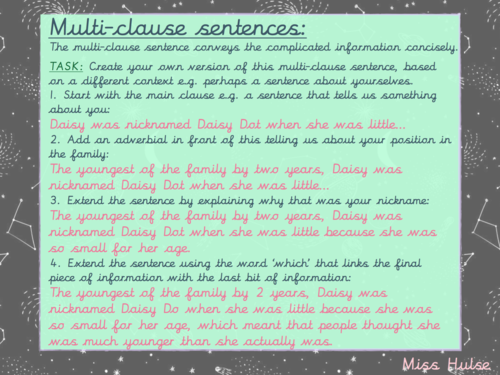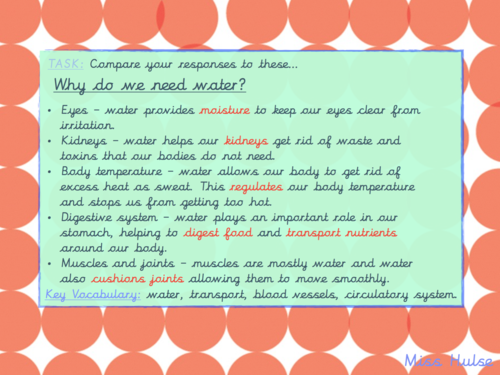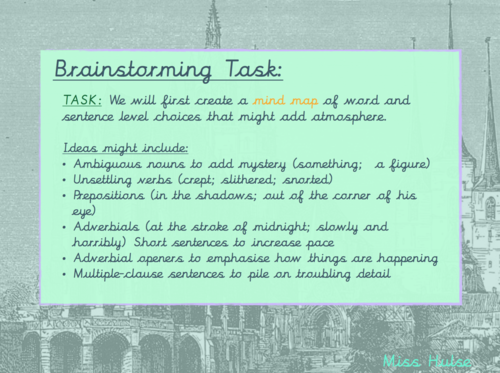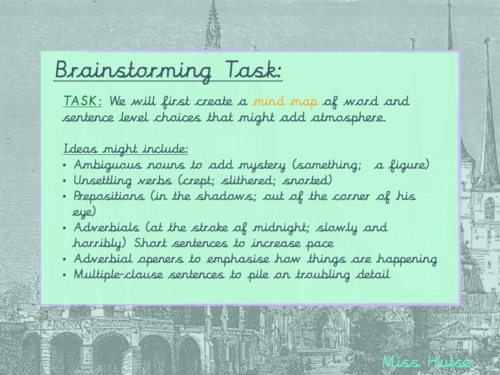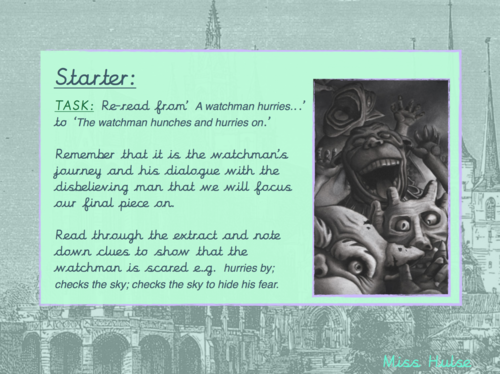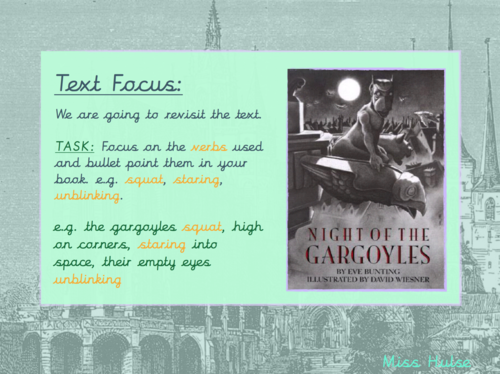143Uploads
20k+Views
18k+Downloads
All resources
Bundle

English - Planetarium Scheme (Upper KS2)
This bundle includes a really lovely English scheme of work for upper KS2, using the book 'Planetarium’, inspired by HertsforLearning and adapted for my class. There are ten lessons in total.
Resource bundle includes: Lesson Powerpoint (PDF) and accompanying resources.
I hope you love this book as much as me and my pupils did!
(01.03.23) UPDATE: PowerPoints Available to edit for every lesson (please note this may need slight reformatting depending on your font settings)

Science - Living things and their habitats L1/2 - The Nature Library (Upper KS2 - Year 6)
This lesson is the first and second lesson from a Science scheme of work for upper KS2 (Year 6), inspired by the Collins Snap Science curriculum and adapted for my class. There are ten lessons in total.
(01.03.23) UPDATE: PowerPoint Available to edit (please note this may need slight reformatting depending on your font settings)
Resource bundle includes: Lesson Powerpoint (PDF) and accompanying resources. I’ve also included my Medium Term Plan for the entire scheme!
Slide one: Title page
Slide two: Learning Intention and Targets for Success
Slide three: Resources
Slide four: Explore
Slide five: Starter Task
Slide six: Feedback
Slide seven: Title page
Slide eight: Learning Intention and Targets for Success
Slide nine: Resources
Slide ten to eleven: Explore
Slide twelve: Living Things classification
Slide thirteen: Plantae Characteristics
Slide fourteen: Challenge
Slide fifteen: Dichotomous Key for Plants
Slide sixteen: Discussion word mat
Slide seventeen to eighteen: Reflect and Review
Slide nineteen: End of the Lesson Quiz
Slide Twenty: End of the Lesson Quiz feedback

Science - Living things and their habitats L5 - The Nature Library (Upper KS2 - Year 6)
This lesson is the fifth lesson from a Science scheme of work for upper KS2 (Year 6), inspired by the Collins Snap Science curriculum and adapted for my class. There are ten lessons in total.
(01.03.23) UPDATE: PowerPoint Available to edit (please note this may need slight reformatting depending on your font settings)
Resource bundle includes: Lesson Powerpoint (PDF) and accompanying resources. I’ve also included a Medium Term Plan for the entire scheme!
Slide one: Title page
Slide two: Learning Intention and Targets for Success
Slide three: Resources
Slide four: Explore
Slide five: Enquire
Slide six: End of the Lesson Quiz
Slide seven: End of the Lesson Quiz feedback

Science - Living things and their habitats L3/4 - The Nature Library (Upper KS2 - Year 6)
This lesson is the third and fourth lesson from a Science scheme of work for upper KS2 (Year 6), inspired by the Collins Snap Science curriculum and adapted for my class. There are ten lessons in total.
(01.03.23) UPDATE: PowerPoint Available to edit (please note this may need slight reformatting depending on your font settings)
Resource bundle includes: Lesson Powerpoint (PDF) and accompanying resources. I’ve also included my Medium Term Plan for the entire scheme!
Slide one: Title page
Slide two: Learning Intention and Targets for Success
Slide three: Resources
Slide four: Exam-Style Starter
Slide five: Explore
Slide six: Feedback
Slide seven: Vertebrates and Invertebrates
Slide eight: Vertebrates
Slide nine: Invertebrates
Slide ten: Invertebrates - arthropods
Slide eleven: Vertebrate Discussion word mat
Slide twelve: Invertebrate Discussion word mat
Slide thirteen: Arthropod Discussion word mat
Slide fourteen: Dichotomous Key for Animals
Slide fifteen: Animalia Fact File Task
Slide sixteen: Animalia Fact File Task feedback
Slide seventeen to eighteen: Classification challenge
Slide nineteen: End of the Lesson Quiz
Slide twenty: End of the Lesson Quiz feedback

Science - Living things and their habitats L7 - The Nature Library (Upper KS2 - Year 6)
This lesson is the seventh lesson from a Science scheme of work for upper KS2 (Year 6), inspired by the Collins Snap Science curriculum and adapted for my class. There are ten lessons in total.
(01.03.23) UPDATE: PowerPoint Available to edit (please note this may need slight reformatting depending on your font settings)
Resource bundle includes: Lesson Powerpoint (PDF) and accompanying resources. I’ve also included a Medium Term Plan for the entire scheme!
Slide one: Title page
Slide two: Learning Intention and Targets for Success
Slide three: Resources
Slide four: Explore
Slide five: Fungi Recap
Slide six: Beneficial/Harmful Table
Slide seven: Explore - Scientific Question
Slide eight: Explore - Prediction
Slide nine: Explore - Variables
Slide ten: Explore - Variables feedback
Slide eleven: Results
Slide twelve: Results table
Slide thirteen: The explanation
Slide fourteen: Conclusion writing
Slide fifteen: Scatter Graph
Slide sixteen: End of the Lesson Quiz
Slide seventeen: End of the Lesson Quiz feedback

English - Planetarium L7 (Upper KS2)
This lesson is the seventh from a really lovely English scheme of work for upper KS2, using the book 'Planetarium’, inspired by HertsforLearning and adapted for my class. There are ten lessons in total.
Resource bundle includes: Lesson Powerpoint (PDF) and accompanying resources.
(01.03.23) UPDATE: PowerPoint Available to edit (please note this may need slight reformatting depending on your font settings)
Slide one: Title page
Slide two: Learning Intention and Targets for Success
Slide three to four: Starter
Slide five to seven: Prepositions
Slide eight: Fronted Adverbials
Slide nine: Descriptive Application Task
Slide ten: Let’s Edit
Slide eleven: Extension
I hope you love this book as much as me and my pupils did!

Science - Living things and their habitats L6 - The Nature Library (Upper KS2 - Year 6)
This lesson is the sixth lesson from a Science scheme of work for upper KS2 (Year 6), inspired by the Collins Snap Science curriculum and adapted for my class. There are ten lessons in total.
(01.03.23) UPDATE: PowerPoint Available to edit (please note this may need slight reformatting depending on your font settings)
Resource bundle includes: Lesson Powerpoint (PDF) and accompanying resources. I’ve also included my Medium Term Plan for the entire scheme!
Slide one: Title page
Slide two: Learning Intention and Targets for Success
Slide three: Resources
Slide four to seven: Explore
Slide eight: Bacteria
Slide nine: Fungi
Slide ten: Micro-organisms overview
Slide eleven: Beneficial/Harmful Task
Slide twelve: Beneficial/Harmful Task feedback
Slide thirteen: Challenge
Slide fourteen: End of the Lesson Quiz
Slide fifteen: End of the Lesson Quiz feedback

Science - Living things and their habitats L9 - The Nature Library (Upper KS2 - Year 6)
This lesson is the ninth lesson from a Science scheme of work for upper KS2 (Year 6), inspired by the Collins Snap Science curriculum and adapted for my class. There are ten lessons in total.
(01.03.23) UPDATE: PowerPoint Available to edit (please note this may need slight reformatting depending on your font settings)
Resource bundle includes: Lesson Powerpoint (PDF) and accompanying resources. I’ve also included a Medium Term Plan for the entire scheme!
Slide one: Title page
Slide two: Learning Intention and Targets for Success
Slide three: Resources
Slide four: Explore
Slide five: Starter
Slide six: Starter feedback
Slide seven: John Ray
Slide eight: Carl Linnaeus
Slide nine: Phillip Miller
Slide ten: Scientific Question
Slide eleven to twelve: Explore
Slide thirteen: Enquire
Slide fourteen: Reflect
Slide fifteen: End of the Lesson Quiz
Slide sixteen: End of the Lesson Quiz feedback
Bundle

Science - Living things and their habitats scheme - The Nature Library (Upper KS2 - Year 6)
This bundle contains ten lessons for a Science scheme of work for upper KS2 (Year 6), inspired by the Collins Snap Science curriculum and adapted for my class. There are ten lessons in total.
Resource bundle includes: Lesson Powerpoint (PDF) and accompanying resources. I’ve also included a Medium Term Plan for the entire scheme!
(01.03.23) UPDATE: PowerPoints Available to edit for every lesson (please note this may need slight reformatting depending on your font settings)

Science - Living things and their habitats L10 - The Nature Library (Upper KS2 - Year 6)
This lesson is the tenth lesson from a Science scheme of work for upper KS2 (Year 6), inspired by the Collins Snap Science curriculum and adapted for my class. There are ten lessons in total.
(01.03.23) UPDATE: PowerPoint Available to edit (please note this may need slight reformatting depending on your font settings)
Resource bundle includes: Lesson Powerpoint (PDF) and accompanying resources. I’ve also included a Medium Term Plan for the entire scheme!
Slide one: Title page
Slide two: Learning Intention and Targets for Success
Slide three: Explore
Slide four: Enquire
Slide five: Challenges (1, 2 and 3)
Slide six: Dichotomous Key for Animals
Slide seven: Dichotomous Key for Plants
Slide eight: Reflect and Review
Slide nine: End of the Lesson Quiz
Slide ten: End of the Lesson Quiz feedback

English - Planetarium L5 (Upper KS2)
This lesson is the fifth from a really lovely English scheme of work for upper KS2, using the book ‘Planetarium’, inspired by HertsforLearning and adapted for my class. There are ten lessons in total.
Resource bundle includes: Lesson Powerpoint (PDF) and accompanying resources.
(01.03.23) UPDATE: PowerPoint Available to edit (please note this may need slight reformatting depending on your font settings)
Slide one: Title page
Slide two: Learning Intention and Targets for Success
Slide three: Starter
Slide four to five: Mars
Slide six: Multi-clause sentences
Slide seven to eight: Multi-clause consolidation
Slide nine:Main task
I hope you love this book as much as me and my pupils did!

Science - Animals including humans L5 - Body Pump (Upper KS2 - Year 6)
This lesson is the final lesson from a Science scheme of work for upper KS2 (Year 6), inspired by the Collins Snap Science curriculum and adapted for my class. There are five lessons in total.
Resource bundle includes: Lesson slides (PDF) and accompanying resources.
(01.03.23) UPDATE: PowerPoint Available to edit (please note this may need slight reformatting depending on your font settings)
Most of these lessons will happily span two lessons as they are knowledge and vocabulary-rich.
Slide one: Title page
Slide two: Learning Intention and Targets for Success
Slide three: Key questions
Slide four: Why do we need water?
Slide five: Is all water the same?
Slide six: What happens if we do not get enough water?
Slide seven: Water happens if we get too much?
Slide eight: Fact File Task

English - Night of the Gargoyles L9/10 (Upper KS2)
This lesson is the ninth and tenth from an incredible English scheme of work for upper KS2, using the book ‘Night of the Gargoyles’, inspired by HertsforLearning and adapted for my class. There are ten lessons in total. This was a great tool for creative writing and encouraged some beautiful descriptive pieces particularly from my boys.
(01.03.23) UPDATE: PowerPoint Available to edit (please note this may need slight reformatting depending on your font settings)
Resource bundle includes: Lesson Powerpoint (PDF) and accompanying resources. Each lesson includes modelling for each task.
Slide one: Title page
Slide two: Learning Intention and Targets for Success
Slide three: Starter
Slide four: Planning Task
Slide five: Self-Reflection
Slide six: Application Task
Slide seven: Final Edit
I hope you love this book as much as me and my pupils did!

English - Night of the Gargoyles L8 (Upper KS2)
This lesson is the eighth from an incredible English scheme of work for upper KS2, using the book ‘Night of the Gargoyles’, inspired by HertsforLearning and adapted for my class. There are ten lessons in total. This was a great tool for creative writing and encouraged some beautiful descriptive pieces particularly from my boys.
(01.03.23) UPDATE: PowerPoint Available to edit (please note this may need slight reformatting depending on your font settings)
Resource bundle includes: Lesson Powerpoint (PDF) and accompanying resources. Each lesson includes modelling for each task.
Slide one: Title page
Slide two: Learning Intention and Targets for Success
Slide three: Starter
Slide four: Final piece overview
Slide five: Brainstorming Task
Slide six: Planning Task
I hope you love this book as much as me and my pupils did!

L1 What is a celestial body? (Year 5 Space)
This lesson is the first lesson from my Primary Science Space scheme of work for upper KS2 (Year 5).
The lesson focuses on Celestial Bodies and has been tailored for pupils after years of being a Year 5 practitioner and Science lead.
Lesson Objective: To identify celestial bodies.
Scientific Question: What is a celestial body?
Enquiry Type: Research using secondary sources.
This is the first lesson of many I hope to convert into user-friendly documents (as my planning slides currently remain of Lynx files).
Resource bundle includes: Lesson slides (PDF and powerpoint) and scaffolded accompanying resources (word and PDF). I’ve included powerpoint and word for ease of editing - although as I know these massively reformat I’ve also included PDF versions.
Slide one: Title page
Slide two: Key vocabulary pre-teach
Slide three: Enquiry type
Slide four to five: Starter (answers included)
Slide six: Celestial bodies input
Slide seven: Celestial bodies task using QR codes for individual research
Slide eight: Fact file template and modelled example
Slide nine: End of the Lesson Quiz
Slide ten: End of the Lesson Quiz feedback

L2 What does our solar system look like? (Year 5 Science)
This lesson is the second lesson from my Primary Science Space scheme of work for upper KS2 (Year 5).
The lesson focuses on Celestial Bodies and has been tailored for pupils after years of being a Year 5 practitioner and Science lead. I have also received Primary Space Education training from the Royal Observatory in Greenwich.
Lesson Objective: To know the planets of the solar system.
Scientific Question: What does our solar system look like?
Enquiry Type: Pattern seeking
This is the second lesson of many I hope to convert into user-friendly documents (as my planning slides currently remain of Lynx files).
Resource bundle includes: Lesson slides (PDF and powerpoint) and scaffolded accompanying resources (word and PDF). I’ve included powerpoint and word for ease of editing - although as I know these massively reformat I’ve also included PDF versions.
Slide one: Title page
Slide two: Key vocabulary pre-teach
Slide three: Enquiry type
Slide four: Planets introduction
Slide five to six: Starter (answers included)
Slide seven: Planet research task with QR code for individual research extension
Slide eight: Planet research answers table
Slide nine: Class model extension activity
Slide ten: End of the Lesson Quiz
Slide eleven: End of the Lesson Quiz feedback

English - Night of the Gargoyles L3 (Upper KS2)
This lesson is the third from an incredible English scheme of work for upper KS2, using the book ‘Night of the Gargoyles’, inspired by HertsforLearning and adapted for my class. There are ten lessons in total. This was a great tool for creative writing and encouraged some beautiful descriptive pieces particularly from my boys.
(01.03.23) UPDATE: PowerPoint Available to edit (please note this may need slight reformatting depending on your font settings)
Resource bundle includes: Lesson Powerpoint (PDF) and accompanying resources. Each lesson includes modelling for each task.
Slide one: Title page
Slide two: Learning Intention and Targets for Success
Slide three: Starter
Slide four: Illustration Focus
Slide five: Atmospheric Writing
Slide six: Writing Task
I hope you love this book as much as me and my pupils did!

English - Night of the Gargoyles L2 (Upper KS2)
This lesson is the second from an incredible English scheme of work for upper KS2, using the book ‘Night of the Gargoyles’, inspired by HertsforLearning and adapted for my class. There are ten lessons in total. This was a great tool for creative writing and encouraged some beautiful descriptive pieces particularly from my boys.
(01.03.23) UPDATE: PowerPoint Available to edit (please note this may need slight reformatting depending on your font settings)
Resource bundle includes: Lesson Powerpoint (PDF) and accompanying resources. Each lesson includes modelling for each task.
Slide one: Title page
Slide two: Learning Intention and Targets for Success
Slide three to four: Editing Starter
Slide five: Text Focus
Slide six to seven: Imitation Task
Slide eight: Expanded Noun Phrases Teach
Slide nine: Expanded Noun Phrases
Slide ten: Sentence Application
Slide eleven: Relative Clause Application
Slide twelve: Main Task
I hope you love this book as much as me and my pupils did!

Spellings - Vowel Suffixes (Upper KS2)
This lesson is part of my SPaG (Spelling, Punctuation and Grammar - sometimes abbrieviated to GPS) collection.
This lesson is the eighth spelling lesson focusing on the vowel suffixes. I followed the Herts for Learning Spelling scheme to create these resources.
Resource bundle includes: Lesson Powerpoint (PDF), a lesson resource including model sentences and also a wordsearch with all of the weeks words in. There are ten spellings per week.
Slide one: Title page
Slide two: Vocabulary
Slide three: Vowel suffixes
Slide four: Spelling practice using techniques
Slide five: Find the definitions task
Slide six: Spelling in context - sentences activity
Slide seven: Word search with the spellings activity

English - And Tango Makes Three L6 (Upper KS2)
This lesson is the sixth from a really lovely English scheme of work for upper KS2, using the book ‘And Tango Makes Three’, inspired by HertsforLearning and adapted for my class. There are ten lessons in total.
(01.03.23) UPDATE: PowerPoint Available to edit (please note this may need slight reformatting depending on your font settings)
Resource bundle includes: Lesson Powerpoint (PDF) and accompanying resources. I’ve also included my Medium Term Plan for the entire scheme!
Slide one: Title page
Slide two: Learning Intention and Targets for Success
Slide three: Recap
Slide four: Overview
Slide five: Diary Entry key features task (WAGOLL)
Slide six: How to write a diary
Slide seven: Features of a diary entry
Slide eight: Modelled diary entry
Slide nine: Diary write and edit
I hope you love this book as much as me and my pupils did!




